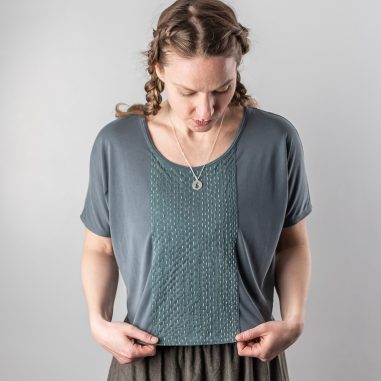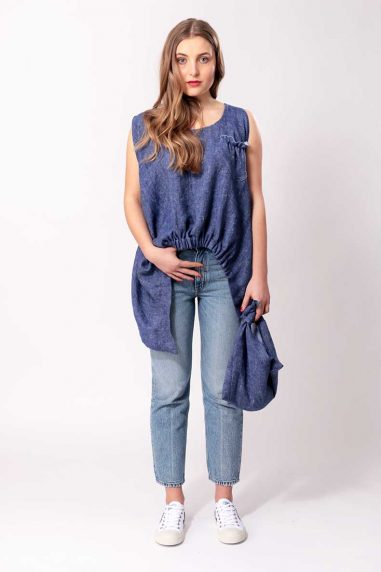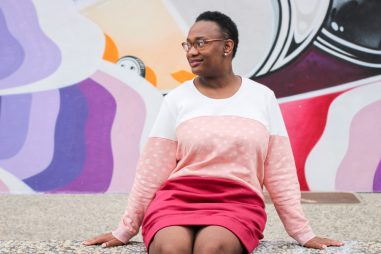Jade – How to Choose Your Fabric
In this post I’ll tell you some more on what to look for when choosing a fabric for your Jade skirt. The instructions already give you some information, but let’s elaborate a bit on that.
Outer layer
The recommended fabric types for the outer layer are light to medium weight knits. Knit fabrics have a nice drape and are easy to mold. I have tried stretch wovens as well but they tend to be a bit more stiff, and the folds don’t sit as nicely as with knit fabric.
Medium weight knits are usually listed as ponte di roma, interlock jersey or double knits. You can recognise these knits by checking the wrong and right side of the fabric. Double knits have the knit structure on both sides, as opposed to having a knit and a purl side. A medium weight fabric will give you soflty rounded folds on your Jade. It also tends to be a little bit easier to sew, so if this is your first time sewing with knit fabric, we’d recommend a double knit. Other medium knits like French terry or coarser knit fabrics are also suitable.


Lightweight knits are perfect for a summer Jade. They are more flexible and the folds are sharper. With lightweight knits I mean knits that you would also use for a T-shirt, often listed just as jersey or as tricot. Be mindful about the fabric content when going with a lightweight jersey. Viscose or rayon fabrics usually have a lot of drape. A percentage of cotton would give the skirt a bit more structure and stay-up force when wearing the skirt.

Lining
In general, you can use the same fabric for both shell and lining. If you’re using a medium weight for the shell however, you can reduce bulk at the seams by using a lightweight knit for the lining. A good rule for selecting your fabrics for this combination is that they should have about the same amount of stretch. This has to do with the construction method: the folds of the outer layer are secured to the lining. If your lining were to be very stretchy (usually rayon/viscose or bamboo jerseys), the folds might pull on the lining, resulting in sagging folds and hems. If you need a lightweight fabric with just a little bit of stretch, you could also look at lightweight stretch wovens. Cotton jerseys also tend to be stretchy but strong.
Stretch
The pattern has a negative ease of 2 3/8″ or 6 cm, which means that the finished garment is smaller than you measurements to ensure a snug fit. The stretch in your fabric should accomodate this negative ease. Look for at least 10-30% stretch: this number is usually listed, at least in online shops. For stretch wovens a percentage of lycra, spandex or elasthan is usually listed. Look for at least 5% of either of these. If you want to determine the stretch in a knit you already bought this is a good way to do that.
Recovery
Apart from the stretch it’s important to pay attention to the recovery of the fabric. Recovery is the ability of a fabric to spring back to it’s original dimensions after stretching. If fabric does not have a good recovery, the skirt will start to sag over time. You can test the recovery by stretching a bit of fabric between your fingers, and then letting go. The fabric should jump back immediately, and the imprint of your fingers should not be visible.
Prints
For the folds to be the main eyecatcher of the skirt, a solid colour fabric would work best. Prints can also work, but I would go for either a more faded or a calm print. Especially when you choose a lightweight fabric, the folds will not stand out as much and they might get lost in a busy print.
Sources
The fabrics I’ve shown here were found at fabric.com (mustard ponte and french terry), cousette.com (wool and viscose jersey) and the local fabric shop and market. I generally find small online French fabric shops (The Sweet Mercerie, Little Fabrics) to have good quality knit fabrics. But I might be a bit biased since I live in France now :) Before you get excited about a colour you like and hit the order button, remember to always check the fabric content. I just ordered a 100% poly double knit by accident, yikes! A cotton or rayon content has a much better feel to it.
If you have any other questions about choosing the right fabric, let us know in the comments!







just bought this pattern, although at 56 I will never make it! But your dedication required that I make the purchase. the fabric guide post is excellent, as I am sure are the other blog posts on the jade skirt. Good luck with paprika patterns.
Wow, that is so nice Ellen! I do hope you get some use out of it at some point though, maybe for someone else? Thanks so much for your support!
I’m older than you Ellen, and I’ve been looking everywhere for a skirt pattern this shape! I’ve already got a skirt like this in rtw and I’ve worn it and worn it! And had many, many compliments, but I despaired of finding a pattern as I’m wouldn’t be confident enough to start on my own, as I’ll never find another one. Well done Lisa for drafting and refining this! You’ll go far
Thanks Maggie!
I have a very drapey fabric (rayon jersey I suspect) I would like to sew with but it is a little transparent. I want to line it. If I use the same fabric for the lining… with both layers being so stretchy, won’t you see wrinkles underneath the top layer when I wear the garment? If both layers
There’s definitely a chance yes, it’s a structured skirt and viscose jersey is a bit too drapey. I’d go with cotton jersey as lining.